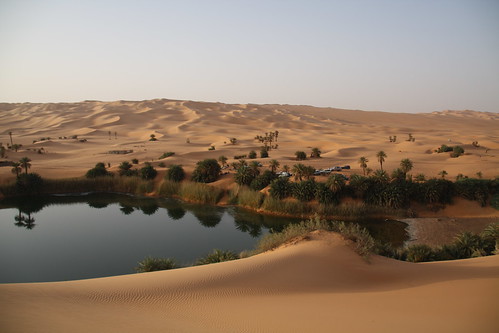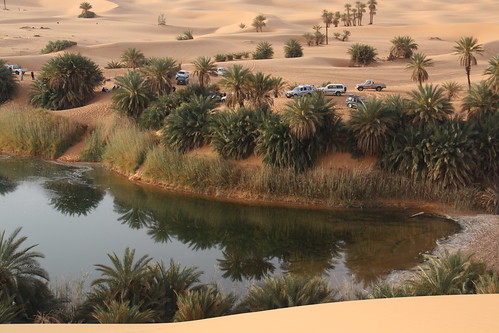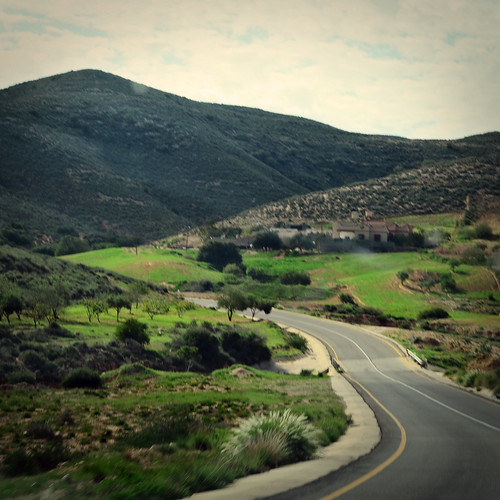Part 2: Natural Section
- Nafusa Mountains – This is very general, but I could write dozens of posts on the different things in the Nafusa mountains. Anyone who hasn’t been hiding under a
rock for the last 8 months will have seen some of the breathtaking plains and
mountain scenery in this region.
There are also several extremely beautiful little-known oases in the area. I’ve heard of at least 2: Ein el zarga and Ein el rumiya, which my dad stumbled across this summer and couldn’t stop talking about for days. He won't give me the photos though, so instead here's Yefren, a town in the mountain range, and a seasonal waterfall near to it :)
(Credit: James Wheeler)
There are also several extremely beautiful little-known oases in the area. I’ve heard of at least 2: Ein el zarga and Ein el rumiya, which my dad stumbled across this summer and couldn’t stop talking about for days. He won't give me the photos though, so instead here's Yefren, a town in the mountain range, and a seasonal waterfall near to it :)
(Source here)
- Jabal al Akhdar
– A beautiful area in eastern Libya, which
should become a protected nature reserve. Heavily forested and full of
wildlife. It was once used by
Umar al Mukhtar as a base from which he waged guerilla warfare against
the Italian colonizers. My shergawi cousins have zardas (picnics) and
even camp here in the autumn, when it
becomes completely green. In fact, these are straight from his fb, hope
he doesn't mind!
- Waw An Namoos – Yep, did everyone know that we have A
VOLCANO in Libya?!
(More pictures here)
Okay, actually it's not a typical mountain-of-fire one. In fact, it
appears to be more of a cluster of oases in volcanic rock, which I think is
formed when a volcano collapses. I’m not educated enough on the subject to
explain it to anyone, and there is a real shortage of literature on it (I’ve
rarely seen such a short Wikipedia page). So who’s going to go and see it first?
- Tibesti Mountain range – including several extinct volcanoes, on the borders between Libya and Chad. Traditionally inhabited by the Tabou tribe, many of whom wholeheartedly supported the revolution this year. Home to ancient cave-paintings and a critically endangered species of wild dog, among other things.
- Jabal Ouenat – Another mountain, on the border between Libya, Egypt and Sudan. It contains many natural springs and cave paintings of animals. I can't find a picture to do all this information justice, but suffice it to say we have many beautiful mountains in Libya, which almost certainly hold many secrets. Here is the UNESCO report on it, and here is an article on its discovery from National Geograhic in 1924.
- Jabal Arkenu – Another mountain, nearby to the previous one but fully in Libya this time. It's also included in the UNESCO report. The most interesting thing about this one is that it contains a double-impact crater, dated to be back in the age of dinosaurs. Reading that made me wonder if we shall find any interesting fossils in Libya...
- Weather – Ok, there's no need to tell anybody about our incredible sunshine and the temperatures Libya reaches daily,
but did anyone know that it also snows in Libya? Especially in the mountains and nearby cities like Gheryan, but it reportedly snowed
in AlBayda only last week! I haven’t
managed to find pictures yet, but I did find a video of the last time it snowed a couple of years ago.
- Coastline – Only about 1770km (1100 miles) of mostly pristine shore. Say hello to tourist money, my fellow Libyans!
- Wildlife – This is a tough one, I don't know if any resources are still up to date. I've been told mountain lions are extinct, sadly, and gazelles are very rare. There is no shortage of wolves and hyenas in the uninhabited areas though.
Geckos (ابو بريص) are a common sight on the outside walls of your house at night, and I even saw a chameleon on my grandparents' grape vine once! Of course, there are camels, snakes and scorpions galore. We also have several species of birds of prey. I have no idea if this was an urban myth, but my mum says that in her childhood she heard that a man was eaten by a crocodile in Werfalla. That would be worrying.
Less worryingly, there are dolphins near our shore!
I can't find it anymore, but there was a lovely video of a man (one of the thuwwar perhaps?) playing with one in waist-deep water on facebook a while ago.
For more info go here and here. There is a very nice wildlife display in the Saraya museum in Tripoli's fort, which I made a point to visit every time I came to Libya as a child. I highly recommend it to everyone.
(See more: LYM)
- Wildlife – This is a tough one, I don't know if any resources are still up to date. I've been told mountain lions are extinct, sadly, and gazelles are very rare. There is no shortage of wolves and hyenas in the uninhabited areas though.
Geckos (ابو بريص) are a common sight on the outside walls of your house at night, and I even saw a chameleon on my grandparents' grape vine once! Of course, there are camels, snakes and scorpions galore. We also have several species of birds of prey. I have no idea if this was an urban myth, but my mum says that in her childhood she heard that a man was eaten by a crocodile in Werfalla. That would be worrying.
Less worryingly, there are dolphins near our shore!
I can't find it anymore, but there was a lovely video of a man (one of the thuwwar perhaps?) playing with one in waist-deep water on facebook a while ago.
- Bonus feature – Escapees! Many of Gaddafi’s elite were in the habit of keeping private
zoos, and even protected reserves (محميات) full of exotic non-native animals. When the areas were taken
by the thuwwar, some managed to escape or had their gates left open. At least, that's how i suspect these things got out here! I don’t
know how many there are or the likelihood of finding them, but if you’re lucky
you could run into all kinds of creatures.
(Posted by Dr Idris Elgaid)
(I can't remember who posted this, please forgive me/let me know)
All of this is just scratching the surface, and there exist
treasures in all corners of the country. Waterfalls near Derna (pictured below),
the cliffs of Tobruk, the valley of Bani Walid after the rains, and the rich
pastures of Msellata (pictured below). A little different from what you'd expect of North Africa isn’t it?
ما شاء الله, تبارك الله بأحستن الخالقين
اللهم أجعل بلدنا امناُ و أحفضه
If that isn't enough for you, you can read some more here and see more here. And don't forget to see my last post on the cultural treasures of Libya, if you haven't!
This
amazing tourism potential will have to be very carefully planned, with routes
and tourist lodgings regulated to minimise disturbance to the habitat, but if
done properly this will result in a large source of sustainable income for the
country, reducing our dependance on oil and diversifying our economy.
PS. Before you go off on an expedition, please don’t forget
there are a lot of unexploded mines lying all over various remote areas in
Libya, particularly in the southern region dating all the way back to the Chad
war in the 80s. Do your research before going anywhere off the well-trodden
path, safety comes first. في أمان الله















No comments:
Post a Comment